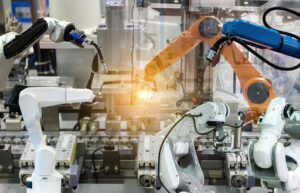 After understanding the basics of Machine Learning (ML) and looking at the different approaches one can adopt, we shall now appreciate the impact ML is having on manufacturing. We hope that this blog proves helpful to readers from the manufacturing world. Read on!
After understanding the basics of Machine Learning (ML) and looking at the different approaches one can adopt, we shall now appreciate the impact ML is having on manufacturing. We hope that this blog proves helpful to readers from the manufacturing world. Read on!
ML applications are descending from the white-collar financial analytics world into the brick-and-mortar world with the advances coming into data speed and processing speed of computers. It is increasingly deployed for quality checks, process optimization, and predictive maintenance in factories. It no longer remains in the realm of research. Now, the world realizes its true potential and utilizes it for better results in its products and processes.
Let’s look at five different ways ML brings value to manufacturing:
Quality Checks
Internal defects of equipment cannot be detected easily. Sometimes expert QA personnel are also not able to detect the flaws in goods through observation. However, ML can help increase accuracy significantly. Measurement equipment and intelligent cameras can record quality-related data. ML algorithms can use such data to predict and identify future defects in quality.
- A global steel manufacturing company uses predictive analytics capabilities of ML algorithms to predict and detect flaws in steel products early on in the production cycle.
- A utility company uses depth analysis techniques from stereo cameras to understand the pattern of vegetative growth around the utility lines and deploy the manpower for doing the pruning activity.
Predictive Maintenance
For predictive maintenance, data is accumulated over time to track the condition of the equipment. The objective is to find patterns that could help predict and ultimately avoid failures. Companies use predictive maintenance majorly for reducing downtime. If you can predict failures in advance, necessary repair measures can be taken ahead of time, and downtime can be avoided.
Demand forecasting and inventory management
Demand forecasting and inventory management are closely related. Demand forecasting involves playing with a lot of data and employing accountants and specialists. Instead, ML algorithms can make the process less labor-intensive and more accurate. If demand is forecasted accurately, inventory can be managed better.
Supply chain and warehouse management systems generate a lot of data that can be used to forecast demand and manage inventory. ML algorithms can accurately tell production and warehouse managers the production and stock levels to maintain, respectively.
Robots
Manufacturers are beginning to reap the  rewards of employing robots on their shop floor. Whether it is robotic equipment that is a part of the production process or a robot that transports material from one place to another ( explore robotic offerings from Rucha Yantra here), ML-powered robots increase efficiency on the shop floor. They reduce errors caused by humans and perform tasks that are too dangerous for humans, thus increasing safety.
rewards of employing robots on their shop floor. Whether it is robotic equipment that is a part of the production process or a robot that transports material from one place to another ( explore robotic offerings from Rucha Yantra here), ML-powered robots increase efficiency on the shop floor. They reduce errors caused by humans and perform tasks that are too dangerous for humans, thus increasing safety.
Rucha Yantra is at the forefront of developing next-gen material handling solutions for manufacturers. Employing tech like ML in our products has always been our endeavor. Stay tuned to our blog series to understand next-gen technologies in depth.



